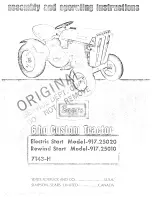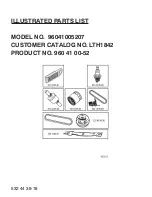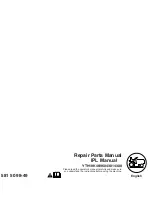
GB - 17
HYDRAULIC OIL SYSTEM
Checking Hydraulic Oil Level
1. Start the unit and run it to operating
temperature (about 10 minutes).
2. Shut off engine. Engage parking brake.
3. Remove the left side panel. (Figure 7)
4. Remove any dirt that may be around the
oil fill plug and remove plug.
5. Check hydraulic oil level. The oil level
should be at or near the top.
6. Add SAE 20W/50 oil as needed. Do not
overfill.
7. Install oil fill plug.
8. Install the left side panel.
SHORT TERM
NEVER spray unit with high pressure water
or store unit outdoors.
Inspect unit for visible signs of wear,
breakage or damage.
Keep all nuts, bolts and screws properly
tightened and know unit is in safe working
condition.
Store unit in a cool, dry protected area.
LONG TERM
Clean unit thoroughly with mild soap and low
pressure water and lubricate (See on
page 17 in Maintenance). Touch up all
scratched painted surfaces.
Remove weight from wheels by putting
blocks under frame or axle.
Fuel System
Gasoline left in the fuel system for extended
periods without a stabilizer will deteriorate,
resulting in gum deposits in the system.
These deposits can damage the carburetor
and the fuel hoses, filter and tank. Prevent
deposits from forming in the fuel system
during storage by adding a quality fuel
stabilizer to the fuel. Follow the
recommended mix ratio found on the fuel
stabilizer container.
To treat the fuel system for storage:
1. Add fuel stabilizer (Ariens part number
00592900) according to manufacturers’s
instructions.
2. Run engine for at least 10 minutes after
adding stabilizer to allow it to reach the
carburetor.
NEVER store the engine with fuel in the fuel
tank inside of a building with potential
sources of ignition.
To Take the Unit Out of Storage
1. Refer to the engine service manual to
prepare the engine for service.
2. Put fresh, clean fuel in the fuel tank.
3. Begin the maintenance schedule.
WARNING: HYDRAULIC FLUID
can result in severe burns. Fluid in
hydraulic system can penetrate
skin and result in serious injury or
death.
Be sure to stop the engine before
doing any work on hydraulic parts.
Keep body and hands away from
pin holes or nozzles which expel
hydraulic fluid when under
pressure. Use paper or
cardboard, not hands, to search
for leaks.
Ensure all hydraulic fluid
connections are tight and all
hydraulic hoses and lines are in
good condition before applying
pressure to system.
FOREIGN FLUID INJECTED
INTO BODY can result in
gangrene. Fluid must be surgically
removed within a few hours by a
doctor familiar with this form of
injury.
Figure 7
Oil Filter
Oil Fill Plug
STORAGE
WARNING: AVOID INJURY.
Read and understand entire
Safety section before proceeding.






































